Last updated on
Single-ply membrane roofing systems, such as thermoplastic polyolefin (TPO) and polyvinyl chloride (PVC), are known for their exceptional durability, lifespan, and sustainability – ideal for many roofing applications.
Innovative single ply membrane roofing systems have been quietly revolutionising the roofing industry. Single ply membranes are an advanced roofing solution specifically designed for waterproofing flat roofs, utilising a single layer of rubber-like synthetic material, and solves an array of roofing requirements across different structures. From flat to sloping roofs, single ply membranes offer unparalleled weather protection, waterproofing, thermal regulation, flexibility, fire resistance to colour variety and sustainability; choosing the suitable membrane could significantly impact a building’s resilience and energy consumption. But what is it exactly?
What is a single ply membrane roofing system?

A single ply membrane roofing system uses a single layer of synthetic material to cover the roof. This material is typically made from specialist plastics applied in a sheet form. A single ply membrane roof system is lightweight, durable, and energy-efficient and applies to various roof types.
What are the benefits of using a single ply membrane roofing system?
- Exceptional quality, durability, and lifespan: Single ply membrane roofing systems, made from high-quality synthetic materials, offer outstanding protection from all weather extremes, UV radiation, punctures, tears, and abrasions.
- Application versatility: Single ply membranes are available in various thicknesses and sizes, tailored to suit the specific requirements of different projects. They can be installed on flat roofs, sloping roofs, or irregularly shaped structures.
- Sustainable roofing option: Single ply membranes are recyclable and offer several energy-efficient benefits. They provide a high level of insulation, lowering heating and cooling costs for the building.
- Waterproofing: Single ply membranes are specifically engineered to provide a seamless and watertight covering, effectively safeguarding the underlying structure from water infiltration, leaks, and damage.
- Thermal performance: Single ply membranes can help regulate the temperature indoors, reducing the need for excessive heating or cooling. This results in lower energy bills and a reduced carbon footprint.
What are the two main types of single ply membranes?
There are two main types of single ply membranes: TPO and PVC.
TPO membranes, made from thermoplastic polyolefin, are a type of plastic that is highly resistant to weathering and UV radiation. TPO membranes are also very flexible and easy to install, making them a good choice for complex roof shapes.
PVC membrane, made from polyvinyl chloride, is a strong and durable plastic. PVC membranes are also waterproof and fire-resistant, making them a good choice for buildings located in areas with high winds or heavy rain.
There are four reasons why you might choose PVC over TPO for your single-ply roofing system:
- PVC is more durable than TPO. PVC membranes have a higher resistance to punctures, tears, and abrasions and are more resistant to weathering and UV radiation. PVC is a good choice for buildings with harsh climates or high winds.
- PVC is more fire-resistant than TPO. PVC membranes have a Class A fire rating, meaning they will not ignite or spread flames. PVC is a good choice for buildings that are required to meet strict fire safety codes.
- PVC is available in a wider variety of colours than TPO. PVC membranes are available in various colours, including white, black, grey, and red.
- PVC is more sustainable than TPO. PVC membranes are made from recycled materials. PVC is a good choice for environmentally conscious building owners.
How can single ply roofs reduce energy costs?
Single-ply roofs offer exceptional thermal performance by helping to regulate the temperature indoors and reducing the need for excessive heating or cooling – lowering energy consumption for heating and cooling, reducing energy costs and a smaller carbon footprint.
The rise of single ply membranes
The rise of single ply membrane roofing systems, particularly TPO and PVC, which can have a service life of 50+ years, marks a significant shift towards sustainable, durable, and energy-efficient roofing solutions. These systems provide exceptional weather resistance and thermal performance and cater to various architectural needs with flexibility and variety. As environmentally conscious building practices become more prevalent, the choice between TPO and PVC membranes allows property owners to tailor their roofing systems to specific climate conditions, safety requirements, aesthetic preferences, and sustainability goals. With the potential to significantly reduce energy costs and environmental impact, single ply membrane roofing systems are a testament to the industry’s evolution towards more innovative, versatile, and eco-friendly materials.
Table of Contents




